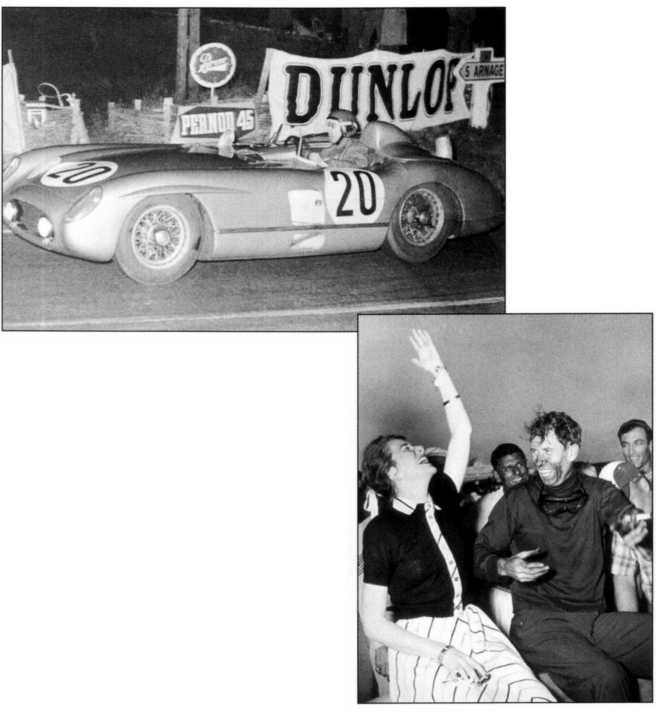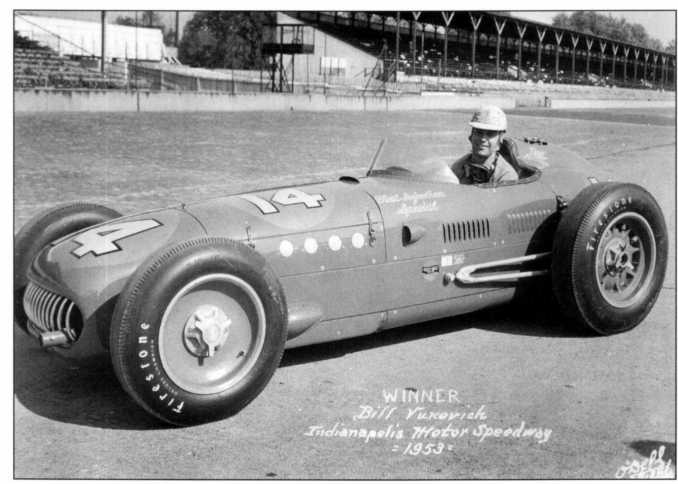Against Death and Time: One Fatal Season in Racing's Glory Years (21 page)
Read Against Death and Time: One Fatal Season in Racing's Glory Years Online
Authors: Brock Yates


Pierre Levegh at the wheel of
the ill-fated 300SLR
Mercedes-Benz prior to his
death at LeMans. The
impact of the accident sent
the engine and Front suspension assembly into the
crowd while Levegh, wearing
no seat belt, as was the practice in those days, was
pitched from the cockpit
and killed.
John Fitch celebrates a 1953 victory while driving for
the Cunningham sports car team. With him is his
wife, Elizabeth. During the 1955 LeMans race she
stayed in Switzerland and heard a report on
U.S. Armed Forces radio that it was her husband,
not his co-driver Pierre Levegh, who had been
involved in the catastrophic crash.

Bill Vukovich in the revolutionary Kurtis-Kraft 500A fuel-injection special that carried him to
victory at Indianapolis in 1953 and 1954 with a near miss in 1952.
Who in God's name were these people, who dealt with death so
casually? Were they all insane? All obsessed with a death wish?
"Motorized Lemmings?"-as Newsweek columnist John Lardner
denounced them following the Vukovich crash. Surely some of them
had come home from the war restless for action, bored with the Ike
and Mamie good life that had overwhelmed the prosperous, vinyl- and
dacron-coated nation with its Barcaloungers, its drip-dry fashions, its
automatic everything, and its nightly dose of network feel-good.
Others, like Jack Kerouac and his fellow beatniks, were rebelling in the
coffeehouses of Greenwich Village and Haight-Ashbury, while some,
wilder and more lethal, were forming motorcycle gangs like the Hells
Angels, Booze-Fighters, Satan's Sinners, and Outlaws.
An Englishman once observed that at some point, all sane young
men in their late teens or early twenties will attempt to kill themselves
in a looney, risk-taking adventure. The poet Richard Hugo, who,
before being cursed with alcohol and depression, was a pilot in World
War II, confirmed the suspicion. Following V-E day, his squadron was
stationed in Sicily, training for future combat. Their aircraft, P-47
fighters with giant radial engines, were claimed to be unditchable in
water. Flight engineers warned all the pilots that landing in water
meant certain death. In the summer of 1945 a fellow pilot and friend
of Hugo's was returning from a training flight over the Bay of Naples
when, on a whim, he decided to try a water landing with the gear up.
He was killed instantly. Hugo would later ponder the possibility that
deep in the psyche of all young men lies a hatred of peace and safety
and an irresistable urge to flout all rules and conventions. He suggested that his friend might have chosen the risk as opposed to the
prospect of returning home to the cushy domesticity of postwar America. His choice was to play Russian roulette with his airplane
and his own mortality in the cauldron of war.
Years later, Michael Cimino would have one of the characters in his
classic film The Deer Hunter play the same game with his own .45
automatic, when there was no gambling involved. This urge to walk
the edge seemed particularly tied to war, whereas conventional thinking presumed that human nature would be to seek to preserve one's
life rather than waste it. Yet following the American Civil War, young
men rushed west to face the dangers of savage Indians, cattle stampedes, rustlers, fierce weather, and drunken gunfighters rather than
languish in the tranquility of the East. So too for the World War I vets
who migrated to Paris as the Lost Generation, there to booze and barfight themselves insensate. Looked at in this light, the men who
unleashed their passions in race cars and on motorcycles in the late
1940s and the 1950s were hardly breaking new ground in terms of
mad, self-absorbed risks to life and limb.
Ironically, the technology that rose out of the industrial creativity
energized by the war effort on all sides offered even more macabre
opportunity for self-imposed danger. The cars competing at places
like Indianapolis and in European road racing were light years more
advanced than those of the prewar years, thanks to quantum leaps in
metallurgy, fuels, bearing surfaces, lightweight alloys, and synthetic
materials of all kinds. But regardless of the fevered increases in performance, the men riding inside those incredible capsules remained
as fragile and physically vulnerable as ever.
Bill Vukovich's death caused a short, frantic outcry in the national
press and among a few politicians who denounced the sport of automobile racing as barbaric madness appealing to only the basest, most
ghoulish human instincts. Several bills to ban racing totally were
introduced in Congress, but were ignored. Homer Capehart, the
powerful Republican senator from Indiana, was sure to roadblock
any such legislation, which meant certain death in the Upper House.
The danger and carnage at Indianapolis seemed to trace a course
in American society that ran in direct opposition to the pallid, pastelhued lifestyle now recalled from the 1950s. In the midst of the saccharine sweetness that engulfed daily living and that enraged
Kerouac and his ilk, automobile racing stood as a steaming fissure of
violence and death on an otherwise tranquil landscape.
Of the thirty-three men who climbed into race cars at the start of
the 1955 Indianapolis 500, eighteen of them would die violent deaths
in races-three of them before the year was ended. All of the top five
finishers were doomed, as were Keller, Elisian, and McGrath, while
two others would suffer horrific injuries that would end their careers.
Half a century later, when two major wars were fought in Iraq and
American casualties barely reached the triple digits, the notion of a
sporting activity that consumed the lives of over half its participants
borders on the demented. Such levels of danger would simply not be
tolerated today. Life has become too precious and too easily preserved
to accept the idea that death and injury are realistic components of
war, much less of a sport. Lawmakers, insurance underwriters, social
activists, safety groups, editorialists, and moralists of all stripes would
be at full cry at the first hint of such potential carnage. Risk-taking,
once an accepted component of life, has in the past few decades been
relegated to the closet with other antisocial activities, leaving the men
who knowingly faced destruction in 1955 among the more bizarre
and perverted of humankind.
Returning to Los Angeles, I received word, as expected, from the
editors of the Saturday Evening Post that my story had been cancelled.
I was settling back into my little apartment to devise another project
when I received a call from a friend who edited a small, struggling
sports car magazine based in New York titled Sports Cars Illustrated.
His European correspondent had met a lovely girl while on vacation in
Monte Carlo and, being a wealthy Italian who didn't need the work, had
quit on the spot. The editor needed someone to cover the upcoming Le Mans 24-Hour race in France in less than two weeks. If I was available, a free plane ticket, modest expenses, and $500 would be mine.
Having no real prospects for work and figuring a week or two in Paris
and environs might be good for the soul, I jumped at the offer.
As I readied myself for the trip to France, updating my passport,
packing, and arranging airline reservations, I couldn't resist making
one more trip to Travers and Coon's shop to fathom their reaction to
Vuke's death. Jim Travers was alone when I arrived early one morning. The Keck streamliner was in its customary spot on jack-stands in
the middle of the shop floor, surrounded by spare parts. Travers was
seated at his small desk, littered as always with blueprints, work
orders, and invoices. "Look at this," he said, a hint of bitterness in his
voice. He handed me a sheet of paper from the Speedway listing the
finishing order and the prize money. Vukovich was placed twentyfifth, with winnings of $10,833.64, a total inflated by the bonus money
he received for leading so many laps before crashing. "At least he's
ahead of McGrath. They've got him listed twenty-sixth. I hope Vuke
understood that the nitro shit jack was using didn't work. That ain't
much solace, but at least it's something."
Travers reached into the pile on his desk and pulled out an
eight-by-ten photo. It was a shot taken from behind the second
turn facing down the long back straight. Ward's car could be seen
scuffing the wall in a cloud of dust, with Keller and Boyd close
behind. In the foreground, headed into the chaos that was about to
commence, was Vukovich. "Take a close look at that," said Travers,
handing me the picture.
I examined it closely, then handed it back. "It looks like what
everybody described, basically," I shrugged.
"Except for one thing. Look closely at Vuke's head. It's tilted downward. I think he was reaching into his lap, looking for the cloth he
always carried to wipe his goggles. In the second he took his eyes off the track, that may have been enough for him to get into Boyd.
Maybe, just maybe, if he'd had that extra second, he might have
missed the whole thing."
"That close, huh?" I asked.
"That close. That much difference. Right at that point on the track
he's hard on the throttle, coming off the corner at maybe 140, 150.
One second makes a world of difference at that speed."